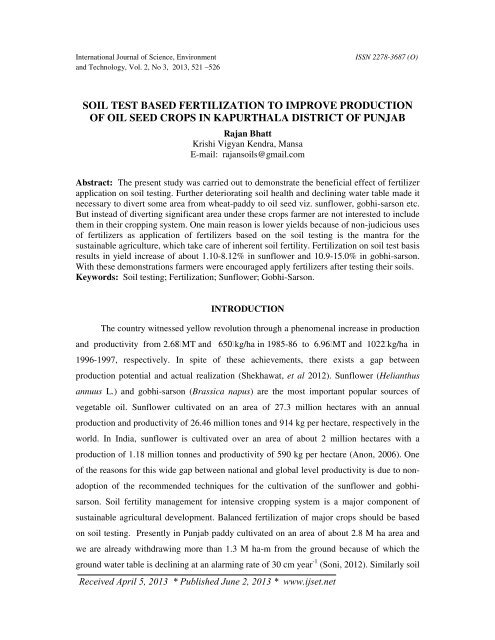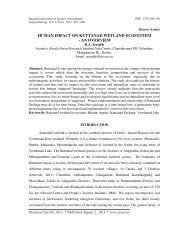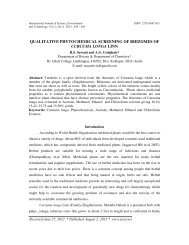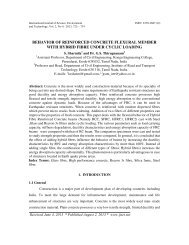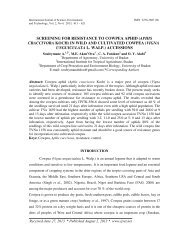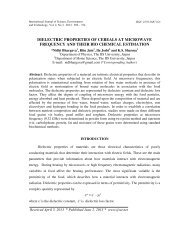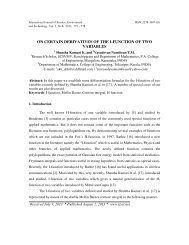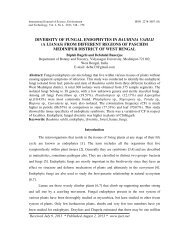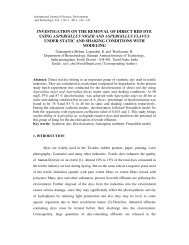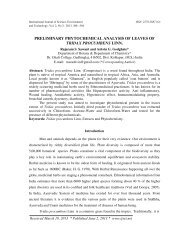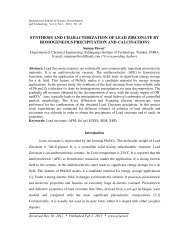soil test based fertilization to improve production of oil seed crops in ...
soil test based fertilization to improve production of oil seed crops in ...
soil test based fertilization to improve production of oil seed crops in ...
Create successful ePaper yourself
Turn your PDF publications into a flip-book with our unique Google optimized e-Paper software.
International Journal <strong>of</strong> Science, Environmentand Technology, Vol. 2, No 3, 2013, 521 –526ISSN 2278-3687 (O)SOIL TEST BASED FERTILIZATION TO IMPROVE PRODUCTIONOF OIL SEED CROPS IN KAPURTHALA DISTRICT OF PUNJABRajan BhattKrishi Vigyan Kendra, MansaE-mail: rajan<strong>s<strong>oil</strong></strong>s@gmail.comAbstract: The present study was carried out <strong>to</strong> demonstrate the beneficial effect <strong>of</strong> fertilizerapplication on <strong>s<strong>oil</strong></strong> <strong>test</strong><strong>in</strong>g. Further deteriorat<strong>in</strong>g <strong>s<strong>oil</strong></strong> health and decl<strong>in</strong><strong>in</strong>g water table made itnecessary <strong>to</strong> divert some area from wheat-paddy <strong>to</strong> <strong>oil</strong> <strong>seed</strong> viz. sunflower, gobhi-sarson etc.But <strong>in</strong>stead <strong>of</strong> divert<strong>in</strong>g significant area under these <strong>crops</strong> farmer are not <strong>in</strong>terested <strong>to</strong> <strong>in</strong>cludethem <strong>in</strong> their cropp<strong>in</strong>g system. One ma<strong>in</strong> reason is lower yields because <strong>of</strong> non-judicious uses<strong>of</strong> fertilizers as application <strong>of</strong> fertilizers <strong>based</strong> on the <strong>s<strong>oil</strong></strong> <strong>test</strong><strong>in</strong>g is the mantra for thesusta<strong>in</strong>able agriculture, which take care <strong>of</strong> <strong>in</strong>herent <strong>s<strong>oil</strong></strong> fertility. Fertilization on <strong>s<strong>oil</strong></strong> <strong>test</strong> basisresults <strong>in</strong> yield <strong>in</strong>crease <strong>of</strong> about 1.10-8.12% <strong>in</strong> sunflower and 10.9-15.0% <strong>in</strong> gobhi-sarson.With these demonstrations farmers were encouraged apply fertilizers after <strong>test</strong><strong>in</strong>g their <strong>s<strong>oil</strong></strong>s.Keywords: S<strong>oil</strong> <strong>test</strong><strong>in</strong>g; Fertilization; Sunflower; Gobhi-Sarson.INTRODUCTIONThe country witnessed yellow revolution through a phenomenal <strong>in</strong>crease <strong>in</strong> <strong>production</strong>and productivity from 2.68 MT and 650 kg/ha <strong>in</strong> 1985-86 <strong>to</strong> 6.96 MT and 1022 kg/ha <strong>in</strong>1996-1997, respectively. In spite <strong>of</strong> these achievements, there exists a gap between<strong>production</strong> potential and actual realization (Shekhawat, et al 2012). Sunflower (Helianthusannuus L.) and gobhi-sarson (Brassica napus) are the most important popular sources <strong>of</strong>vegetable <strong>oil</strong>. Sunflower cultivated on an area <strong>of</strong> 27.3 million hectares with an annual<strong>production</strong> and productivity <strong>of</strong> 26.46 million <strong>to</strong>nes and 914 kg per hectare, respectively <strong>in</strong> theworld. In India, sunflower is cultivated over an area <strong>of</strong> about 2 million hectares with a<strong>production</strong> <strong>of</strong> 1.18 million <strong>to</strong>nnes and productivity <strong>of</strong> 590 kg per hectare (Anon, 2006). One<strong>of</strong> the reasons for this wide gap between national and global level productivity is due <strong>to</strong> nonadoption<strong>of</strong> the recommended techniques for the cultivation <strong>of</strong> the sunflower and gobhisarson.S<strong>oil</strong> fertility management for <strong>in</strong>tensive cropp<strong>in</strong>g system is a major component <strong>of</strong>susta<strong>in</strong>able agricultural development. Balanced <strong>fertilization</strong> <strong>of</strong> major <strong>crops</strong> should be <strong>based</strong>on <strong>s<strong>oil</strong></strong> <strong>test</strong><strong>in</strong>g. Presently <strong>in</strong> Punjab paddy cultivated on an area <strong>of</strong> about 2.8 M ha area andwe are already withdraw<strong>in</strong>g more than 1.3 M ha-m from the ground because <strong>of</strong> which theground water table is decl<strong>in</strong><strong>in</strong>g at an alarm<strong>in</strong>g rate <strong>of</strong> 30 cm year -1 (Soni, 2012). Similarly <strong>s<strong>oil</strong></strong>Received April 5, 2013 * Published June 2, 2013 * www.ijset.net
522 Rajan Bhatthealth is also decl<strong>in</strong><strong>in</strong>g day by day as micro-nutrients start appear<strong>in</strong>g and we have <strong>to</strong> applythese micro-nutrients viz. iron, z<strong>in</strong>c and manganese. Therefore diversification is the must <strong>to</strong>eradicate these problems. Sunflower and Gobhi-sarson are the two most important <strong>oil</strong> <strong>seed</strong><strong>crops</strong> which are popularize among the farmers under the FLDs for diversification. UnderFLDs, demonstrations were conducted on <strong>to</strong> the farmer’s field <strong>to</strong> transfer la<strong>test</strong> <strong>production</strong>technology generated by the Punjab Agricultural University, Ludhiana among the variousdevelopment agencies for its further dissem<strong>in</strong>ation amongst the farm<strong>in</strong>g community. Theobjective <strong>of</strong> the carried out study is <strong>to</strong> demonstrate the effect <strong>of</strong> <strong>s<strong>oil</strong></strong> <strong>test</strong> <strong>based</strong> <strong>fertilization</strong> onthe yield potential <strong>of</strong> the sunflower and gobhi-sarson so that farmers <strong>of</strong> the region gotbenefitted by judicious use <strong>of</strong> the fertilizers after <strong>test</strong><strong>in</strong>g their <strong>s<strong>oil</strong></strong>.MATERIALS AND METHODSFor proper implementation <strong>of</strong> the Johl committee report,(2002) we must have <strong>to</strong> divert at least 1.0 M ha area fromthe rice (cover<strong>in</strong>g 2.8 M ha), then decl<strong>in</strong><strong>in</strong>g water table asthen demand is as per supply viz. 3.0 M ha-m secondlycultivation <strong>of</strong> <strong>oil</strong> <strong>seed</strong> and pulses will certa<strong>in</strong>ly <strong>improve</strong>the <strong>in</strong>herent fertility <strong>of</strong> the <strong>s<strong>oil</strong></strong>. In Punjab, KVKs aredo<strong>in</strong>g excellent job <strong>in</strong> encourag<strong>in</strong>g the farmers <strong>to</strong> divertmaximum possible area from wheat –paddy <strong>to</strong> <strong>oil</strong> <strong>seed</strong>and pulses as KVKs are well equipped with FLDs underwhich demonstrations are carried with <strong>improve</strong>dcultivation practices side by side with the farmers<strong>in</strong>digenous technologies and yield <strong>in</strong>crements willcerta<strong>in</strong>ly encourage the farmers <strong>to</strong> adopt those <strong>improve</strong>d techniques for improv<strong>in</strong>g the<strong>production</strong> potential <strong>of</strong> these <strong>crops</strong>. Under FLDs dur<strong>in</strong>g year 2010 we carried out 16demonstrations on sunflower and 10 demonstrations on gobhi-sarson show<strong>in</strong>g the importancefertilizer application on the basis <strong>of</strong> <strong>s<strong>oil</strong></strong> <strong>test</strong><strong>in</strong>g. Kapurthala (A formerly pr<strong>in</strong>cely state) is one<strong>of</strong> the smallest district <strong>of</strong> Punjab both <strong>in</strong> terms <strong>of</strong> area and population. The district is divided<strong>in</strong><strong>to</strong> two non–cont<strong>in</strong>uous parts viz. Phagwara block <strong>in</strong> one part and the rema<strong>in</strong><strong>in</strong>g four blocks<strong>in</strong> the other part. The agro-climatic conditions <strong>of</strong> the district Kapurthala co<strong>in</strong>cide with theCentral Punjab with smooth-pla<strong>in</strong> <strong>to</strong>pography. Kapurthala is located at 31 o 36’ North and75 o 37’ East on the sultanpur road at an attitude <strong>of</strong> 221 meters. Inherent <strong>s<strong>oil</strong></strong> fertility <strong>of</strong> the
S<strong>oil</strong> Test Based Fertilization <strong>to</strong> Improve Production ……….. 523selected plots was analyzed <strong>in</strong> our <strong>s<strong>oil</strong></strong> and water <strong>test</strong><strong>in</strong>g lab. S<strong>oil</strong> <strong>test</strong> <strong>based</strong> nutrientmanagement results <strong>in</strong> higher yields. Application <strong>of</strong> potassium results <strong>in</strong> yield <strong>in</strong>crease from2.8 <strong>to</strong> 6.3% <strong>in</strong> the region as compared <strong>to</strong> control plots <strong>in</strong> K deficient <strong>s<strong>oil</strong></strong>s (Bhatt and Sharma,20011). Under the Front l<strong>in</strong>e demonstrations, we selected 22 locations on the random basis,out <strong>of</strong> which 12 selected for sunflower and 10 locations selected for gobhi-sarson. Initial <strong>s<strong>oil</strong></strong>fertility status <strong>of</strong> all the demonstration plots were analyzed <strong>in</strong> the <strong>s<strong>oil</strong></strong> and <strong>test</strong><strong>in</strong>g lab <strong>of</strong> ourKendra after collect<strong>in</strong>g surface <strong>s<strong>oil</strong></strong> samples from the 0-15 cm depth. Sunflower variety(PSH-569) were sown <strong>in</strong> the 2 nd week <strong>of</strong> Feb and harvested <strong>in</strong> June while gobhi-sarson sown<strong>in</strong> the last <strong>of</strong> Oc<strong>to</strong>ber and harvested <strong>in</strong> the middle <strong>of</strong> March. S<strong>oil</strong> organic carbon (SOC)content was determ<strong>in</strong>ed by Walkley and Black (1934). The content <strong>of</strong> available P and K wasdeterm<strong>in</strong>ed as described by Olsen et al. (1954) and Merv<strong>in</strong> and Peech (1950) respectively.Gra<strong>in</strong> yield data was statistically analyzed us<strong>in</strong>g Student t-<strong>test</strong> at 5% level <strong>of</strong> significance.For each demonstration we selected a plot <strong>of</strong> 0.4 ha and then divide <strong>in</strong><strong>to</strong> two parts <strong>of</strong> 0.2 ha.Subplots were allotted with T 1 (Plot receiv<strong>in</strong>g fertilizers as per <strong>s<strong>oil</strong></strong> <strong>test</strong><strong>in</strong>g) and T 2 (Plotreceiv<strong>in</strong>g fertilizers as per farmer's tradition).RESULTS AND DISCUSSIONSTo prove the importance <strong>of</strong> fertilizer management as per <strong>s<strong>oil</strong></strong> <strong>test</strong> reports over farmer’spractice 12 demonstrations <strong>of</strong> sunflower and 10 demonstrations <strong>of</strong> gobhi-sarson were carriedout <strong>in</strong> the year 2009-2010. As far as economics <strong>of</strong> sunflower and gobhi-sarson wasconcerned, it was reported that by spend<strong>in</strong>g 1 rupee we earn a benefit <strong>of</strong> up<strong>to</strong> 2.48 <strong>in</strong>sunflower and 2.66 <strong>in</strong> gobhi-sarson (Table 1) and a yield <strong>in</strong>crease <strong>of</strong> 6.1% <strong>in</strong> sunflower and13.2% <strong>in</strong> gobhi-sarson were reported which is ma<strong>in</strong>ly because <strong>of</strong> fertilizer management onthe <strong>s<strong>oil</strong></strong> <strong>test</strong> basis.Table 1: Yield obta<strong>in</strong>ed under FLDs and farmer’s practice <strong>of</strong> <strong>oil</strong><strong>seed</strong> and pulse <strong>crops</strong>Sr. Name <strong>of</strong> Variety No. Are Average PercentNo. Crop<strong>of</strong> a yield (ha) <strong>in</strong>creasFLD (ha) FLD FP e oversthe FP1. Sunflower PSH 12 4.8 20.8 19.6 6.15692. Gobhi-SarsonGSC-6 10 4.0 16.3 14.4 13.2
524 Rajan BhattEconomic impact (cont<strong>in</strong>uation <strong>of</strong> previous table)Average Cost <strong>of</strong>cultivation (Rs./ha)DemonstrationLocalCheckAverage GrossReturn (Rs./ha)LocalCheckAverage Net Return(Pr<strong>of</strong>it) (Rs./ha)DemonstrationDemonstrationLocalCheckCost -BenefitRatio18558 18058 46072 43414 27515 25357 1:2.489800 9000 26100 22680 16300 13680 1:2.66The Table 2 shows crop wise performance <strong>of</strong> the demonstration <strong>in</strong> terms <strong>of</strong> yield <strong>in</strong>creasedover local check or farmers practice and there was a significant <strong>in</strong>crease <strong>in</strong> yield <strong>of</strong>demonstration over farmers’ practices, thus result<strong>in</strong>g <strong>in</strong> a net higher <strong>in</strong>come. We selected 12locations and analyze their <strong>in</strong>herent fertility status, then apply<strong>in</strong>g fertilizers accord<strong>in</strong>gly. Thefields <strong>of</strong> all the demonstrat<strong>in</strong>g farmers were low <strong>in</strong> organic carbon (%) therefore it wasrecommended <strong>to</strong> apply 25% more urea fertilizer than the recommendation viz 157 kg/ hawhereas muriate <strong>of</strong> potash was applied only when K was found <strong>to</strong> be low i.e. @ 137 kg/ ha.All the demonstrations were low <strong>in</strong> K-status also (table 2).Table 2: Result <strong>of</strong> front-l<strong>in</strong>e demonstration on sunflower (PSH 569) dur<strong>in</strong>g 2010.Locations S<strong>oil</strong> Fertility status Yield (q ha -1 ) % <strong>in</strong>crease <strong>in</strong>OC (%) P (kg K (kg FLDs Control yield overha -1 ) ha -1 )controlL 1 0.32 11.0 120.5 17.1 16.3 4.83L 2 0.28 10.5 110.0 21.0 20.0 5.10L 3 0.26 9.50 125.0 21.1 20.0 5.26L 4 0.24 10.0 130.5 22.2 21.0 5.71L 5 0.28 10.0 135.0 22.9 21.3 7.69L 6 0.34 8.0 102.0 20.6 19.4 6.25L 7 0.36 8.5 105.5 19.3 18.1 6.56L 8 0.34 9.0 115.0 21.4 20.3 5.71L 9 0.28 9.0 120.0 20.3 19.4 4.61L 10 0.28 9.5 125.0 22.2 20.5 8.12L 11 0.26 10.0 120.0 20.6 19.2 7.80L 12 0.32 10.5 116.0 21.4 20.5 4.61Mean 0.30 9.7 118.7 20.8 19.7 6.10Median 21.0 20.0Mode 22.2 20.0The gra<strong>in</strong> yield <strong>in</strong> FLDs plots recorded <strong>to</strong> be as high as 22.9 q/ha and <strong>to</strong> as low as 17.05 q/haand the percent <strong>in</strong>crease <strong>in</strong> FLDs plot over farmers plots was found <strong>to</strong> be 4.61% <strong>to</strong> 8.12%
526 Rajan Bhattstage have also affected the yields obta<strong>in</strong>ed. The <strong>in</strong>crease observed <strong>in</strong> the FLD plot over thefarmer practice was ma<strong>in</strong>ly due <strong>to</strong> the application <strong>of</strong> fertilizers as per <strong>s<strong>oil</strong></strong> <strong>test</strong> reports which isstatistically higher than the farmer’s practice. Our study revealed the importance <strong>of</strong> <strong>s<strong>oil</strong></strong><strong>test</strong><strong>in</strong>g <strong>in</strong> sunflower and gobhi-sarson. Thus, balanced nutrition concept focus on the use <strong>of</strong>plant nutrients <strong>in</strong> a def<strong>in</strong>ite proportion as required by the <strong>crops</strong> which is possible only if oneknows the available nutrient status <strong>of</strong> his <strong>s<strong>oil</strong></strong>s. S<strong>oil</strong> <strong>test</strong><strong>in</strong>g helps <strong>in</strong> understand<strong>in</strong>g the<strong>in</strong>herent fertility status <strong>of</strong> the <strong>s<strong>oil</strong></strong>s which further helps <strong>in</strong> improv<strong>in</strong>g the livelihood <strong>of</strong> thefarmers <strong>of</strong> the region by improv<strong>in</strong>g the <strong>production</strong> and by effective fertilizer management.Therefore, <strong>s<strong>oil</strong></strong> <strong>test</strong><strong>in</strong>g is a must for every farmer before f<strong>in</strong>aliz<strong>in</strong>g his <strong>fertilization</strong> schedule.LITERATURE CITED[1] Anonymous, 2006. Annual Progress Report <strong>of</strong> AICRP on Oil<strong>seed</strong>s (Sunflower),Direc<strong>to</strong>rate <strong>of</strong> Oil<strong>seed</strong>s Research, ICAR, Hyderabad, India, pp. 230.[2] Bhatt R and Sharma M. 2011. Potassium scenario- a case study <strong>in</strong> the Kapurthala distric<strong>to</strong>f Punjab, India. J Res Punjab Agric Univ 48: 24-27.[3] Prasad R 2003. Prote<strong>in</strong>-energy malnutrition and fertiliser use <strong>in</strong> India. Ferti News 48: 13-26.[4] Gautam US, Paliwal DK and Seema N 2007. Improvement <strong>in</strong> livelihood security for smalland marg<strong>in</strong>al farmers through Front L<strong>in</strong>e Demonstrations on <strong>oil</strong><strong>seed</strong> and Pulse <strong>crops</strong> <strong>in</strong>central India. Indian Res J Ext Ed 7:1-5.[5] Shekhawat K, Rathore SS, Premi OP, Kandpal BK, and Chauhan JS 2012. Advances <strong>in</strong>Agronomic Management <strong>of</strong> Indian Mustard (Brassica juncea (L.) Czernj. Cosson): AnOverview. International Journal <strong>of</strong> Agronomy 2012: 1-14.[6] Soni V 2012. Ground water loss <strong>in</strong> India and an <strong>in</strong>tegrated climate solution. Curr Sci102: 1098-1101[7] Johl SS 2002. Agricultural <strong>production</strong> pattern adjustment programme <strong>in</strong> Punjab forproductivity and growth, Govt. <strong>of</strong> Punjab, Chandigarh.[8] Walkley A and Black CA 1934. An exam<strong>in</strong>ation <strong>of</strong> the digestion method for determ<strong>in</strong><strong>in</strong>g<strong>s<strong>oil</strong></strong> organic matter and a proposed modification <strong>of</strong> the chromic and titration method. S<strong>oil</strong> Sci37: 29-38.[9] Olsen SR and Sommers LE 1982. Phosphorus In: Methods <strong>of</strong> <strong>s<strong>oil</strong></strong> analysis, part 2, 2 ndedn., Page A. L., Miller, R. H. and Keeney, D. R. (eds.). S<strong>oil</strong> Sci Soc <strong>of</strong> Am, Madison, WI.Pp. 403-48.


